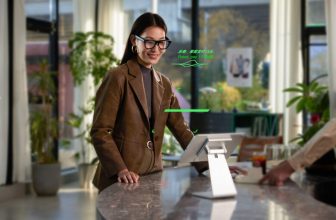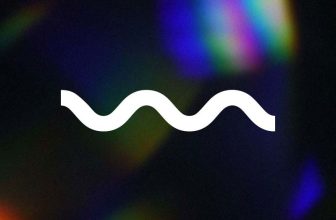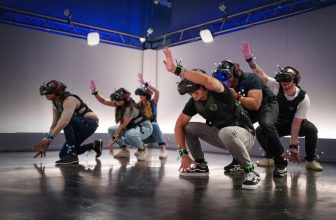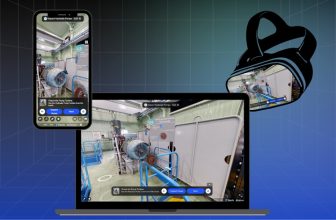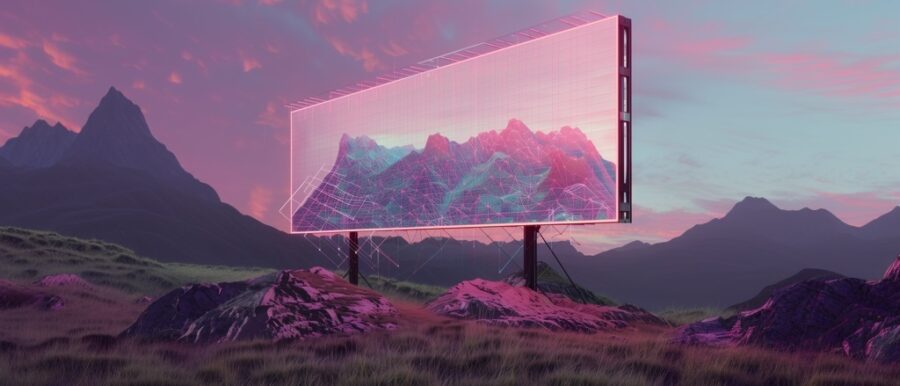
Explore the realm of augmented reality (AR) advertising, as showcased by renowned global brands, and gain valuable insights on crafting effective AR ads with our user-friendly brand guide.
AR, or augmented reality, provides brands with a unique and effective way to engage with consumers that traditional media cannot achieve. The number of AR users worldwide is expected to reach 1.73 billion by 2024, indicating that AR still has untapped potential in terms of its usage and advertising reach. Social platforms such as Snapchat are also recognizing the value of AR advertising and are actively introducing sponsored AR filters. However, despite these advancements, certain brands are still neglecting AR advertising in favor of more familiar methods.
To help address this, we’ve put together a quick guide covering what AR advertising is, some of the main AR platforms that you should be aware of, recent examples of great AR campaigns, and a step by step approach to help you plan your own AR campaign.
What does Augmented Reality Advertising refer to?
Augmented reality advertising involves the use of AR technology to create marketing campaigns or experiences that enhance the user’s real-world view with digital content such as graphics, text, or video. Unlike traditional advertising formats, AR advertising has the potential for high recall and engagement, and can be accessed by anyone with a smartphone. Unlike other immersive technologies, AR advertising does not require consumers to own additional hardware. Additionally, the release of innovative products like the Apple Vision Pro has opened up new opportunities for AR advertising among highly engaged and affluent consumers who can afford expensive hardware.
10 Great Examples of AR Advertising
AR advertising is available in various formats, including traditional ones. Out Of Home (OOH) is a suitable option for augmented reality due to the use of QR codes during the pandemic. Experiential and event-based marketing are also popular choices for brands to showcase AR. Additionally, certain AR tools, such as Ikea’s Place app, improve the user’s buying experience, fostering trust and value without appearing overly promotional. Here are some notable AR campaigns from recent years.
Pizza Hut – PAC-MAN AR (2021)
What was the fastest selling game console in the world? Based on the number of units sold, a pizza box. In 2021, Pizza Hut teamed up with creative development studio Tool and ad agency GSD&M to reimagine the iconic 80s arcade game PAC-MAN in an incredible AR campaign. Through an awesome combination of nostalgia and modern technology, Pizza Hut cooked up one of the best AR ad campaigns we’ve ever seen.
Utilizing the WebAR platform 8th Wall, Pizza Hut and their collaborators provided customers with a unique pizza box experience. By scanning the box using a smartphone camera, customers were able to witness the virtual presence of PAC-MAN through augmented reality, directly on top of the box via their phone’s web browser. The campaign, accompanied by a Superbowl Ad, achieved remarkable success with a whopping 741 million impressions, sales of 10.6 million PAC-MAN pizza boxes, extensive coverage on mainstream TV news, and numerous mentions in publications such as Hypebeast, designboom, and Food & Wine.
Dune: Part Two (2024)
Using AR filters and lenses is a more straightforward approach to advertising. These tools utilize a smartphone camera to seamlessly incorporate digital elements into the user’s surroundings, such as blending a user’s face into a virtual environment. As a promotional tactic for the highly anticipated release of the movie “Dune: Part Two,” Warner Bros developed a Snapchat Lens called the “Dune Lens.” This Lens enabled users to transform into Fremen, the iconic desert warriors of the Dune planet, and experience riding sandworms.

Snapchat users had the opportunity to purchase tickets for the film’s release by tapping on the lens and custom Cameo stickers in addition to watching video ads. The Dune AR campaign demonstrated how a straightforward idea could promote user interaction and encourage the creation of user-generated content using AR technology. This campaign also resulted in an uptick in ticket sales through the microsite linked to the lens.
Red Bull – World Series Cliff Diving (2023)
Red Bull, the popular energy drink brand, is famous for their adventurous stunts and extreme sports. However, it can be difficult for consumers to fully grasp the magnitude of their events without being physically present. To address this issue, Red Bull partnered with AR agency Rock Paper Reality for a clever campaign promoting their World Series Cliff Diving. Using the 8th Wall platform, they created a WebAR experience that enabled users to witness the thrilling spectacle of a 70ft dive via their smartphones. It was truly a breathtaking experience!
Coca-Cola Zero – #TakeATasteNow (2023)
On September 25, 2023, Coca-Cola introduced an out-of-home (OOH) campaign that enabled users to modify the 3D content of the advertisements in real-time using their smartphones. The campaign, known as #TakeATasteNow, was active in the UK for a duration of three weeks. Users were able to virtually obtain a bottle of Coca-Cola Zero and were provided with a voucher to acquire an actual bottle from any Tesco store participating in the campaign. This initiative exemplifies the prevalent trend of B2C marketing that offers interactive augmented reality (AR) experiences alongside rewards for user engagement.
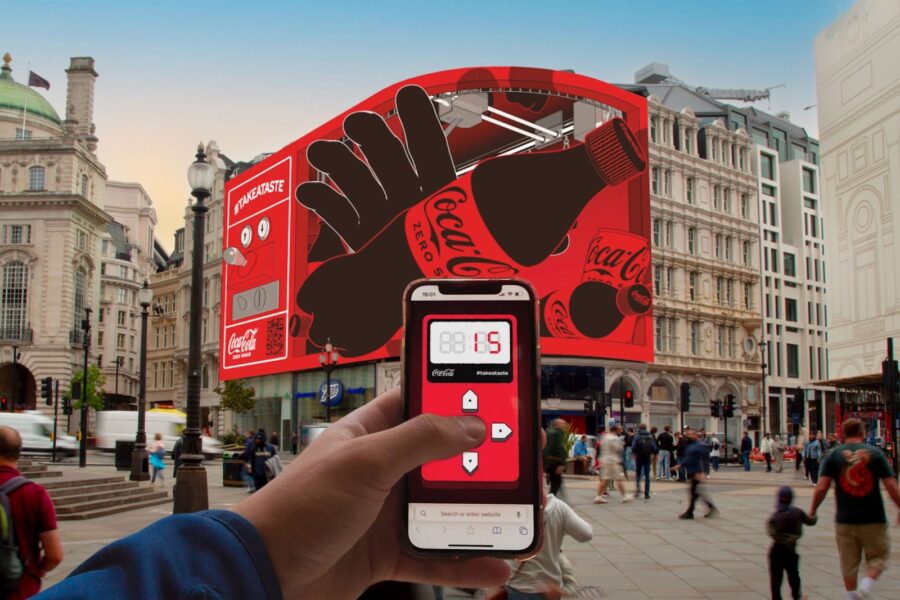
AR is a great way to gamify your advertising. As the Coca-Cola campaign shows, you can think of an AR ad as the start of a mini quest for your viewers, with the reward for engagement being some kind of real-life discount or free version of your product. If you want to take this approach further, check out some full-scale scavenger hunt style AR experiences like Adidas’ 2019 ComplexCon drop, which was a masterclass in building hype and engagement at an event using AR.
Burger King – ‘Burn That Ad’ (2019)
Set a McDonald’s ad on fire and get a free Whopper. That’s the basic concept for Burger King Brazil’s AR campaign, and it worked brilliantly. The creative agency behind the 2019 campaign, David Sao Paolo, sought to solve two crucial problems. First: that BK’s main rival in Brazil, McDonald’s, spent four times as much on paid media than they did, and second, that users weren’t really making the most of BK’s in-app purchases at the time. The solution? Create a way to boost in-app purchases while simultaneously piggybacking off the competition’s ads.
The David agency team put in a lot of effort to gather all types of McDonald’s advertisements, such as billboards, digital ads, tray papers, social media banners, and even images from Google searches. These were used to create a database that could track these ads. When a user captured any real-life McDonald’s content, the BK AR experience would start, showing flames burning the McDonald’s ad away and revealing a coupon for a free Whopper. This would then direct users to the BK app. It’s a brilliant idea!
Top Gun: Maverick – AR Call Sign Generator (2022)
Designed to promote the release of the iconic Top Gun: Maverick (2022) movie, this call sign generator by creative studio Powster helped fans answer the immortal question for Top Gun fans everywhere: #WhatsMyCallSign. Using 8th Wall face-tracking, the filter placed holographic helmets on users and asked them a series of questions that resulted in a personalized call sign. The experience produced a shareable selfie with the user in their helmet, and users could also take the quiz on a dedicated website.
Localized for over 40 territories, Powster also created tailored versions for various brand partners like Showcase, Vue Entertainment, IMAX, Coke, and even Lady Gaga. The call sign generator helped create huge hype for the film on social media, and it was even picked up in a US TV interview featuring Jon Hamm!
Pepsi Max – ‘Unbelievable’ Bus Shelter (2015)
Perhaps one of the most viral advertising campaigns we’ve seen incorporate AR into a built environment is Pepsi Max’s iconic ‘Unbelievable’ bus shelter spot. The award-winning ad relied on cameras built into a bus shelter with a live feed of the street behind to create the illusion of asteroids falling, UFOs invading, and tentacles coming up from the pavement to grab unlucky passersby.
“In a society where almost everyone carries an AR-compatible device (such as smartphones) with them constantly, brands can take advantage of a valuable chance to enhance traditional OOH ad platforms like billboards and bus stops by incorporating technology. Additionally, the widespread familiarity with QR codes, thanks to the Covid-19 pandemic, presents an added opportunity for people to engage with AR experiences.” – Webb Wright, for The Drum
The project created by Grand Visual was an early example of AR advertising that quickly gained popularity, attracting millions of views and significantly boosting Pepsi Max sales during its run. This serves as a demonstration of how AR has the power to greatly enhance traditional OOH media through creative thinking and innovation. It is important to note that AR campaigns don’t need to be overly complex to make a significant impact.
Ikea – Place App (2017)
The concept of “try before you buy” has been a common application of AR for several years. It is a valuable tool for enhancing the customer experience. One example is Ikea’s Place app, which was launched in 2017. This app addresses the issue of uncertainty regarding how furniture will fit in a specific space before making a purchase. By allowing customers to visualize the furniture in their own environment, Ikea increases customer engagement, minimizes financial losses from returns, and gains a competitive advantage.
Netflix – Open Anime AR Portal (2022)
To capitalize on the growing surge of mainstream interest in anime in the wake of shows like Attack On Titan and One Piece, Netflix created an immersive anime experience and microsites using 8th Wall’s image tracking capabilities. With the help of Powster and Hello Tello, Netflix’s Creative Labs worked to create beautiful immersive AR portals showcasing various anime themes. The portals, which were activated by QR codes on OOH and social ads worldwide, also came with stunning microsites with their own unique immersive adventures. Check them out at www.openanime.com

Circle K & Niantic – Pokémon Go Rewarded AR (2023)
Last year, Circle K, a convenience store chain, collaborated with Niantic, the developers of Pokémon Go, to introduce a range of augmented reality (AR) advertisements within the app. These ads, called Rewarded AR ads, made use of Niantic’s AR platform, 8th Wall. Circle K was among the first companies to test these ads in Pokémon Go. During the gaming experience, players were shown an ad in the form of a floating balloon. Interacting with the ad led them to a large coffee cup from Circle K. This ultimately enticed them to visit a nearby Circle K store and enjoy a cup of coffee.
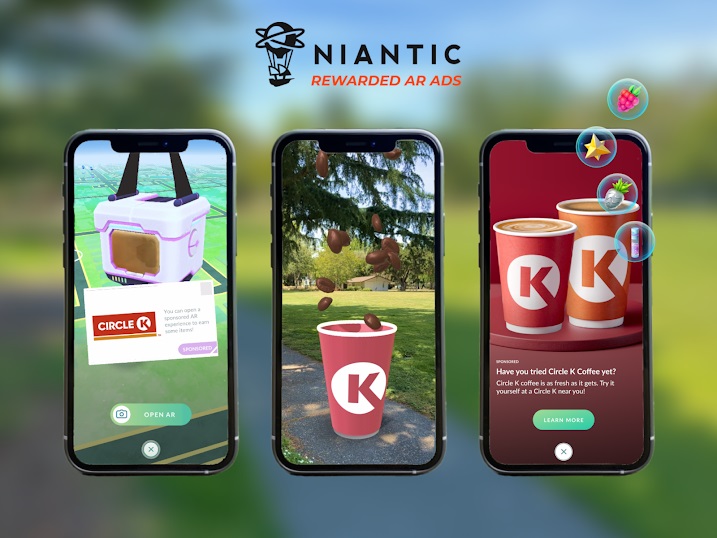
According to Marketing Dive, the campaign saw an average engagement rate of 76% and an average completion rate of 95%, highlighting the stickiness of AR ads compared to traditional formats. Ultimately, campaigns like Circle K’s pave the way for an explosion of similar experiences in popular AR spaces like Niantic’s flagship game, and challenge brands to come up with new and creative ways to captivate already engaged users in those worlds.
How to Create Branded AR Experiences in 2024
If you want to take advantage of the potential of AR advertising, this guide will walk you through the process. Whether you’re working alone on a small campaign and need to learn the fundamentals or you’re seeking to incorporate an AR experience into a larger campaign, these steps will assist you in thinking strategically about utilizing AR in your upcoming marketing endeavor.
Choose the appropriate time (and platform) for your action.
Selecting the appropriate moment and strategy to employ augmented reality (AR) is crucial. As discussed in our recent article “How to lunch an XR Product,” unveiling a new product during a launch event or initiating a fresh campaign with AR can yield impressive results. AR has the potential to greatly amplify experiential marketing due to its immersive nature, user engagement, and capacity for social sharing.
Similarly, certain mediums like packaging (Pizza Hut’s PAC-MAN boxes), billboards, or other OOH experiences (like Pepsi’s bus stop) lend themselves to AR. Alternatively, purely digital ads using filters (like Dune: Part Two) or specially-designed AR experiences (like Red Bull Cliff Diving) are also a great fit for AR campaigns.
When making a decision regarding your medium, it is crucial to consider certain distinctions, such as whether you prefer web-based AR (WebAR) experiences and the extent of coding you plan to undertake. Here are a few significant mediums that should be noted.
WebAR
When developing an AR campaign, a significant decision to make is whether to create a specific AR application for your brand or opt for a browser-based experience instead. Creating an AR app, or even integrating AR features into an existing branded app, can offer a more customized branding experience. However, this may inconvenience users who prefer not to download a new app.
A simpler method to connect with customers is by using WebAR, which enables you to offer your AR encounters directly from a web browser. Usually accessed through a smartphone, any user can scan a QR code and immediately engage with the content. An excellent illustration of this is the innovative marketing strategy employed by 19 Crimes, a wine company that has crafted an immersive storytelling experience linked to their wine bottles. Just scan one of their labels with your smartphone camera through their website called “living wines AR experience”, and witness the animated characters on the bottle coming alive.
8th Wall
Niantic’s 8th Wall platform is a major development platform for WebAR & WebVR. They offer a comprehensive solution for creating, publishing and distributing WebAR and WebVR content through their Cloud Editor, AR Engine, and Built-in Hosting options. They also have a ton of examples of recent WebAR campaigns on their website if you’re looking for inspiration!
No-code AR creation tools
If you are planning to develop an AR experience, it is important to consider your coding skills. If you want to create something more elaborate but lack the necessary resources, it may be a good idea to outsource the work to a creative studio that specializes in AR assets. This is especially beneficial if you intend to use 8th Wall’s development suite, which is designed more for developers.
However, there are a number of no-code platforms out there that you can utilise for AR as well, like Zappar, Blippar and Geenee, who all offer various different templated AR experiences and assets that can be easily modified to suit a number of business cases and marketing goals.
Reword: Make a choice regarding your AR marketing objectives.
Selecting your objectives is a customary aspect in all marketing campaigns, including those involving AR. What actions do you desire individuals to take after interacting with your advertisement? Are you aiming for product purchase, increased website traffic for further information, or encouraging sharing of photos and videos using your branded filter? Determine where your AR campaign fits within your marketing funnel and utilize this knowledge to guide the construction process, both in terms of method and platform selection.
3. Plan your customer journey
Whether you’re doing event-based marketing, some kind of packaging QR experience, or even just a creative AR billboard concept, it’s useful to map things out in advance. How do you want your AR experience to function when random members of the public get their hands on it?
Like wireframing in UX design, it can be beneficial to create a rough outline of the user journey, starting from their initial interaction and ending with a clear call to action.
What action do you want the user to take after engaging with your augmented reality (AR) encounter? Is there a linked microsite they should visit? Does your encounter have a specific location requirement, such as utilizing Snapchat’s Geofilters or Google’s Cloud Anchors?
By answering these questions beforehand, you will prevent any issues upon the actual launch. AR aims to provide enjoyment, novelty, and captivation. It would be unfortunate for a brilliant idea to be wasted due to inadequate preparation and avoidable obstacles.
4. Come up with a strong creative concept
Every good advertising campaign is built on one core idea, generally driven by some kind of powerful emotional hook. Pizza Hut’s PAC-MAN is perhaps one of the best examples of a solid creative concept that’s well executed specifically because it relies on AR. The campaign uses AR to play off the nostalgia of the past, back when Pizza Huts were still restaurants with real PAC-MAN machines in them. With a solid creative concept acting as a bedrock, the unique medium of AR can truly come to life. Think about how AR can express your idea better than traditional mediums alone.
5. Learn about key platforms for AR advertising
If you are thinking of incorporating AR into your upcoming marketing campaign, it is crucial to acquaint yourself with several essential platforms. The selection of platforms you opt for will play a significant role in your marketing strategy and potential media investment. Here are some of the primary platforms that you should keep in mind.
Using TikTok for AR Advertising
TikTok is one of the largest social media platforms, with highly engaged users and a demographic that skews toward a younger Gen-Z audience. Typically, the platform has been known for its user-generated content, often comprised of short, energetic videos playing off current cultural tropes and trends. Brands of all shapes and sizes can benefit from the app’s advertising capabilities, which have recently expanded to include better AR advertising features, specifically.
In March of last year TikTok announced the release of Branded Effects as part of their Effect House creation platform, letting brands create custom effects like stickers, filters, and lenses for their marketing campaigns. Branded Effects offer a wide range of customizable filters that let users interact with a brand in a number of ways, from trying on makeup colors and styles, to unlocking animations or overlaying unique stickers related to your brand.
Using Snapchat for AR advertising
Snapchat is another core platform for brands looking to advertise using AR, and the format for content on Snapchat usually follows a similar formula to TikTok: short, impactful videos designed to grab attention. In a recent post, Snap announced Sponsored AR Filters for brands, which lets brands create custom AR filters for their marketing campaigns. Using Snapchat’s Lens Web Builder, advertisers and brands can put together custom branded content with zero outside production costs in less than 10 minutes.
Using Instagram for AR advertising
In 2022, Instagram and Facebook introduced augmented reality (AR) advertising capabilities for brands with the help of Meta Spark. Through AR ads on these platforms, users are able to click on a call-to-action button and access the ad’s camera. Within the camera, they can engage with the AR experience and utilize their smartphone camera to capture photos or videos that can be shared on Instagram Stories. The ad may also display a URL that can direct users to various destinations, such as a microsite or the main website.
To begin creating an AR advertisement on Instagram, you will first need to design it using Meta Spark Studio. Meta offers various resources for creators and brands who are new to AR experiences. Take a look at Meta Spark Learn guides for more information. Like other platforms, your AR effect will need to go through an approval process before it becomes visible. This process is handled through the Meta Spark Hub.
6. Build your AR marketing experience
Finally, after determining the optimal timing for AR implementation, establishing campaign objectives, selecting a platform and medium, and designing the user experience, the next step is to begin the development process. Remember to consider the following aspects once again:
- Are you developing WebAR experiences or building an application?
- Will you be utilizing non-programming solutions for your project or will it necessitate the involvement of developers for the AR implementation?
- Are you constructing internally or outsourcing?
As we’ve mentioned, social media platforms popular with AR filters all have their own DIY studios in one form or another, and each has their own approvals process for branded content. However, if you are planning to come up with a larger scale AR experience, you’ll need to pair with a creative partner who can specialize in designing AR assets and campaigns.
Arprio is here to assist you in optimizing your AR advertising endeavors, regardless of the strategy you choose. Feel free to reach out to us today and provide us with a better grasp of your objectives.
Get Started with AR Advertising
AR advertising provides a distinctive opportunity for brands to leave a lasting impression. It is a medium that has minimal obstacles and aligns perfectly with the prevalent platforms. Moreover, AR excels at enhancing traditional marketing approaches such as outdoor experiences, packaging, and launch events. As AR encounters become increasingly common, brands that become adept at this medium will possess a significant advantage in the future. Ultimately, for brands that think innovatively, AR enables their marketing to follow.



